At the San Juan de Dios Hospital in Costa Rica, Édgar Chacón crossed his fingers and hoped his Covid-19 won’t get worse. If he had to go to the Intensive Care Unit (ICU), there would probably be no room.
Over the last two weeks, this Central American nation, one of the first in the region to start vaccinating against the pandemic and once an example in controlling the disease, has suffered a setback similar to that of Chile and Uruguay: a skyrocketing number of cases despite a good rate of vaccination.
It became the fourth in America with the most infections per 100,000 inhabitants over the last two weeks, behind Uruguay, Argentina and French Guiana, according to data compiled by AFP.
Added to this is a growing number of deaths, comprising only older adults but also the population ranging from 35 to 60 years old. Given this, the government has decided to suspend in-person school for two months and restrict citizen circulation to contain the advance of the pandemic.
“We were fortunate to have access to a bed, but when we went out, there were very sick people waiting outside for attention. And you know what they’re feeling and it’s hard,” details Édgar, 59 years old.
Both he and his wife, Guiselle Mata, overcame hospitalization and illness without entering the ICU, a one-way trip for many Covid patients.
In Costa Rica, almost 4,000 people have died since the pandemic began — 380 in the last 15 days. Although the figures are not as large in comparison to other countries, in a nation of 5 million inhabitants, each death carries a heavy weight.
‘There are no beds. There is nothing’
Cristian Sandoval, 42, did have a serious respiratory setback and entered the ICU of Hospital México, also in the capital, San José. He stayed for 16 days and saw how five people died a few meters from his bed.
“I definitely noticed the advance of this wave. Seeing the full rooms, hearing when the nurses said ‘There is no space; there are no beds; there is nothing.’ It was alarming, because I was critical and I just thought: Now what is going to happen with me?”
Cristian is now recovering at home, though he now requires physical, cardiopulmonary and respiratory therapy.
“The workloads have grown; the increase in patients is significant. The most difficult thing is to enable spaces to attend them. There are days when there are no beds or breathing devices available,” said internist Ricardo Ramos, who sees firsthand the collapse of the health service.
The country averages 2,500 daily cases in the last 15 days. In addition, on Tuesday, Costa Rica broke its record for deaths in a single day, with 48.
The blessing of vaccination
The new wave of infections has its genesis in the overconfidence of the population in the face of encouraging signals through the Easter holidays, said the epidemiologist from the National University of Costa Rica (UNA) Juan Jose Romero.
“Due to exhaustion or fatigue of almost a year restricted, mainly the population group of 35 to 60 years, that until that moment had been taken care of, was overconfident. (…) Now in this group it is the one that occurs more cases and deaths,” he said.
“The main difference now, in addition to the number of cases, is mortality. Young people are dying. It is the part that hits the hardest, it is people who we’re not used to seeing die from a medical situation,” added Dr. Ramos.
The paradox is that the crisis occurs as the government is executing a mass vaccination campaign. It’s the third country in Latin America with the highest percentage of vaccinated individuals, behind Chile and Uruguay.
President Carlos Alvarado expects 65% of the population to be vaccinated by the end of 2021.
As of Thursday, May 20, Costa Rica had imported 1.4 million doses from Pfizer / Biontech and Astrazeneca, with which it has a contract for 4.5 million doses. It is negotiating with the Chinese enterprise Sinopharm.
“This job is extremely difficult, because within the hope of vaccination, we cannot advance with the speed we would like,” acknowledged the Minister of Health, Daniel Salas.
“If it were up to us, two months ago we would have achieved herd immunity, but we lack availability of more doses. We find enormous ironies in this, because we also have no space in our hospitals.”







